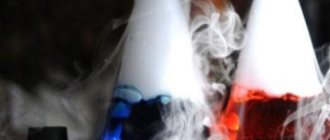Hydrochloric acid poisoning is one of the most dangerous chemical intoxications. After contact with it, a person can expect complex treatment and serious consequences at best, and death at worst.
Hydrochloric acid (HCl, hydrochloric or hydrochloric acid, hydrogen chloride) is an aqueous solution of hydrogen chloride, a clear, colorless, caustic liquid, one of the strongest acids. In the air it “smoke”, forming caustic vapors (fog). Contains 0.5% in gastric juice.
Hydrochloric acid is used:
- in galvanoplasty;
- as part of some types of glue, alcohols;
- as a surfactant - for cleaning ceramics and metals;
- in the textile industry;
- in the food industry (acidity level regulator E507);
- in medicine, together with the enzyme pepsin for low stomach acidity.
Under certain conditions, you can be poisoned by hydrochloric acid both at work and at home.
Causes of sulfuric acid burns
Sulfuric acid is a potent substance that can penetrate into the deep layers of the epidermis. Chemical burns often occur in industrial plants. It is used to purify petroleum products. In the chemical industry, it is used for the production of dyes and fibers, the production of fertilizers, leather dressing, etc. In the domestic sphere, sulfuric acid is used by car owners to prepare electrolyte for batteries.
There are several types of sulfuric acid with different percentages:
- concentrated - 98%,
- tower - 75%,
- battery - 30%,
- diluted (sulphurous) - 10%.
Depending on what type is used, the depth of exposure of the chemical depends. The main causes of acid burns are:
- failure to comply with safety regulations,
- industrial injuries,
- casual contact in everyday life,
- unprofessional use in cosmetology.
Most often, injuries are local in nature, i.e. a small area of skin is affected. Working with a toxic substance can lead to poisoning by its vapors - internal burns. If acid gets into your eyes, it can have the most dire consequences.
La-Cri products and their assistance in wound healing
After the healing process begins, you can begin the gradual use of emollient creams and La-Cri emulsions. Of course, they cannot be regarded as a complete remedy for acid burns, but they can have a moisturizing, restorative and soothing effect on the damaged area of the skin.
Developed on the basis of natural non-hormonal components and free of parabens, fragrances and silicones, La-Cri products provide gentle care for regenerating skin. They help relieve itching and provide sufficient nutrition to damaged skin areas.
Degrees of burn and type of burn
The degree of exposure to sulfuric acid depends on its concentration, the time of exposure to the skin, the depth of penetration and timely provision of assistance to the victim. There are four stages of chemical injury.
- In the first stage, only the upper layer of the epithelium is affected. After providing first aid and removing acid from the body, skin hyperemia appears, which disappears after a few days without drug treatment. Sometimes a burning sensation and itching may occur.
- In the second stage, the skin becomes blistered and swollen. The acid penetrates into the deeper subcutaneous layers, the patient feels a strong burning sensation. Timely assistance provided leads to a favorable outcome, without scarring.
- The third stage is characterized by blistering of the affected area with a cloudy liquid inside, sometimes with blood. The acid penetrated deep into all layers of the skin, including the fat layer. The patient experiences a painful shock and his temperature rises. The affected area turns red, then quickly darkens, and tissue necrosis is observed. The third stage is treated only in a hospital setting.
- At the fourth stage, the chemical penetrates through all layers of the epidermis, affecting tendons and bone tissue. Even with timely medical care, the prognosis can be unfavorable, even death.
There are also types of chemical burns: superficial, when the external parts of the body are affected, vapor poisoning - the poison enters the internal organs and eye burns. The latter is considered the most dangerous, because it is impossible to determine the depth of penetration of the chemical and correctly assess the scale of the damage.
It is believed that the lethal dose of sulfuric acid ingested is 5 mg.
Features of the disease
Children and men are more susceptible to injury than others. If in the latter case the risk is associated with professional activity, then children are injured at home when they come into contact with acetic acid, household chemicals, etc.
Chemical burns caused by different reagents can be fundamentally different from each other. Some do not cause such deep injuries and occur more easily, affecting only the superficial layers.
Alkali and acid burns are considered the most dangerous, as they even affect deep tissues. Acid leads not only to destruction, but also to active dehydration, so the scab will be dry and dense. Alkalis penetrate deep into the skin very quickly, since they have the ability to dissolve fatty and protein components of cells. The scab with such damage is soft and has no boundaries.
Chemical skin burn (photo)
Read more about 1st, 2nd, 3rd, 4th degree chemical burns.
Symptoms of a burn with sulfuric acid
A slight effect of a weak acid solution on the skin is manifested by slight redness with a light crust around the edges. If the substance is not removed in time, bubbles may form. At first, the damaged epidermis will be whitish, then the skin will darken to a gray or brown tint.
The symptoms of a chemical burn with sulfuric acid differ from ordinary thermal injury and depend on the location of the substance.
Skin burns
Sulfuric acid can get on your body, face or limbs. The person begins to feel a strong burning and itching sensation. A thick crust appears, under which chemicals continue to act on the skin. After the wound heals, a purple scar and deformed tissue remain on the skin.
If measures are not taken, tissue necrosis occurs, regeneration of the damaged area does not occur and the limb has to be amputated. The main symptoms of an acid burn include:
- the upper layer of the epithelium peels off,
- the affected area swells,
- a white scab with clear edges appears,
- darkening of the burned area,
- formation of coagulation type necrosis.
The patient feels severe pain, and in the case of severe damage on a large scale, death occurs.
Burns of internal organs
Sulfuric acid entering the body causes more serious consequences. Vapor poisoning can occur in the area of the larynx, esophagus, stomach, and lungs. Inside the body, sulfur vapors turn into liquid substances containing the acid itself and arsenic. Symptoms of vapor poisoning are as follows:
- swelling of the mucous membranes,
- nosebleeds,
- wheezing, sore throat,
- chest cramps
- attacks of suffocation,
- severe pain and swelling in the digestive organs.
Ingestion of acid in liquid form is accompanied by the following symptoms:
- severe cramping pain in all digestive organs,
- vomiting with blood,
- increased salivation,
- stomach upset,
- kidney damage and bright red urine,
- bluish skin,
- disruptions in the functioning of the cardiovascular system,
- dark spots on teeth,
- lips acquire a black-blue tint,
- swelling of the larynx to the point of suffocation.
Subsequently, after suffering a chemical burn to internal organs, a person may develop laryngitis, pharyngitis, pneumonia, etc.
Eye burn from sulfuric acid
The most dangerous condition is the contact of a toxic substance with the mucous membrane of the eyes. Immediately after the acid interacts with the eye, a person begins to feel a strong burning sensation, sharp pain, and profuse lacrimation appears. Bright light causes pain. Further development of the disease is accompanied by the following symptoms:
- vision decreases,
- pallor and cloudiness of the eye cornea,
- swelling of the conjunctiva,
- intraocular pressure increases,
- redness of the eyelid followed by scar formation.
A deep burn leads to complete loss of vision, even despite timely medical assistance.
Clinic of poisoning with hydrochloric acid and its esters
A hydrogen chloride solution enters the human gastrointestinal tract at work when safety rules are violated or intentionally during a suicide attempt. Hydrochloric acid gets on the mucous membrane of the mouth, throat, tongue and causes severe burns and poisoning. The first symptoms of damage to the esophagus and stomach:
- acute pain in the abdomen and chest;
- vomit with blood;
- swelling of the larynx.
In severe cases of poisoning and in the absence of medical care, additional symptoms develop: pulmonary edema, severe pathologies of the kidneys and liver. The pain syndrome can lead to burn shock, which aggravates the victim's condition with possible loss of consciousness.
Symptoms of damage to the esophagus and stomach: acute pain in the abdomen and chest
The victim must be removed from the premises to avoid additional intoxication from toxic fumes. First aid for hydrochloric acid poisoning is to immediately lavage the stomach. The patient is forced to drink about a liter of water and is induced to vomit. If a person exhibits symptoms of traumatic shock, they are given sedatives or painkillers.
Hydrogen chloride solution evaporates quickly in open air. During this process, a toxic haze appears in the air, which harms the human respiratory tract. Symptoms of poisoning by toxic fumes:
- dry cough;
- suffocation;
- burning of mucous membranes;
- tooth damage;
- disruption of the stomach and intestines.
First aid for poisoning with toxic ethers is free access to clean air and rinsing the throat with water or a soda solution.
With prolonged inhalation of poison, the clinical picture may be accompanied by toxic pulmonary edema. Its initial stage is characterized by chest pain and nonproductive cough. If the reagent is removed, all symptoms disappear within an hour (latent period). But at this time the lungs begin to change and lose some functions. Gradually, chest pain and difficulty breathing return, which entail the appearance of wheezing and the onset of the edema process. Completion of lung poisoning is accompanied by the following symptoms:
- bluish or gray tint of the skin and mucous membranes;
- shortness of breath and weak pulse;
- sputum discharge (with blood);
- lack of oxygen in the body and others.
The victim must be immediately taken to the hospital, where a toxicologist will prescribe adequate treatment.
Acid or acid vapor poisoning must be treated in a hospital
First aid for sulfuric acid burns
In case of a burn with sulfuric acid, first aid should be provided immediately. The first thing to do in such a situation is to eliminate the original source of the burn. Further actions depend on the location of the damage.
First aid for skin burns
If the chemical comes into contact with the body, the victim's clothing should be removed to avoid spreading the affected area. The wound is washed with running water for at least 15-20 minutes until all the acid is eliminated. Do not use cloth or napkins for washing, as... fibers from them can get into the wound and subsequently cause inflammation.
Next, the wound is treated with a soda solution. To do this, dissolve a teaspoon of soda in a glass of warm water and wash the wound well with the resulting mixture. If there is no soda, a weak solution of potassium permanganate or soap foam will do. After this, medications are used in the form of ointments, creams or aerosols: Levomekol, Panthenol, Apollo, Povidone-iodine, etc.
The treated area is covered with a sterile bandage or gauze. You can buy ready-made antiseptic wipes soaked in medicine at the pharmacy. You can relieve pain with any analgesic.
After first aid is provided, the patient is taken to the hospital, where the doctor can assess the extent of the damage and prescribe appropriate treatment.
Help with burns of internal organs
Acid contact with internal organs is extremely dangerous. The severity is assessed by the concentration and amount of the chemical substance ingested. The patient needs immediate first aid.
- The victim's stomach is washed. You can drink magnesium.
- Rinse the mouth with soda solution.
- The patient is given to drink as much water as possible.
- In case of severe vomiting, the drink should be warm to reduce the effect of the reagents.
After these manipulations, the patient should be taken to the hospital as quickly as possible.
First aid for burns to the mucous membrane of the eye
What to do if the mucous membranes of the eyes are burned by sulfuric acid. The first thing you need to do right away is rinse it with plenty of water. After the substance is completely removed from the mucous membrane, it is necessary to drip the eye with novocaine 2% to eliminate pain or dicaine 0.5%. Further treatment is carried out in a hospital, after examination by an ophthalmologist.
Consumer Reviews
Darya_OTZ (irecommend.ru) about La-Cri cream for dry skin
“My skin can suddenly begin to peel at any time of the year and usually no cream really helps. Especially body lotions: they either leave an unpleasant film, or have an unpleasant aroma, or are instantly absorbed without any effect.
And then I accidentally came across a sample of La Cree cream for dry skin... and I was pleasantly surprised when I tried it! I started with my hands, applying the cream half an hour before leaving the house. Moreover, I will make a reservation that in cold weather I don’t like to wear gloves and, of course, my hands get quite dry. This simply does not happen with this cream! The skin remains soft and can withstand anything!
Inspired, I decided to slowly apply it to my body and even my face! I especially like it at night: in the morning the skin is “nourished”, looks very vibrant and has absolutely no peeling.
This cream is definitely a favorite on my makeup shelf.
Today I will tell you about a cream that I met more than six months ago.
The very first acquaintance with La Cree was in a sampler. This is the very moment when I was simply incredibly happy to receive a small amount of ml of cream.
After using it, I ran to the Vita Pharmacy and bought this small 30g bottle for 159 rubles. And now I buy it, absolutely, EVERY TIME it runs out.
And now I’ll tell you about the most interesting thing: the ADVANTAGES of this very La-Cri cream.
- Well, where I would like to start is this:
- It does not contain fragrances or dyes
- You can even “smear” a child from 0+ with it
- La-Cri cream for sensitive skin photo
Next, I would like to say about the benefits that I felt:
- He quickly copes with irritation
- Wound healing occurs almost instantly
- It even helps with cramps
- Relieves skin redness
- Reduces itching (it helped me a lot with this after my unsuccessful eyelash extensions. I don’t even want to remember)
- And, of course, it moisturizes and gently cares for your skin.
I think IT'S WORTH THE MONEY because it does everything it promises and MORE! My most favorite cream!
Diagnosis of burns after sulfuric acid
Symptoms of a burn with sulfuric acid are similar to burns caused by other chemicals, therefore, to make a correct diagnosis, the doctor carries out diagnostic measures:
- visual inspection. If acid gets on the skin, study the location of the burn, the depth of penetration, the stage of the disease,
- radiology diagnostics. It is carried out in case of acid ingestion. Using radiography, the extent of the lesion is assessed and perforation of the stomach and esophagus is detected. Computed tomography allows you to determine damage to hollow organs,
- laboratory research. In case of acid vapor burns, the patient's blood pH is measured, a urine test is prescribed, and blood is taken to determine the level of hemoglobin, coagulability, and the concentration of electrolytes in the plasma.
Burns of sulfuric acid to internal organs are similar to other diseases and in order to distinguish them, differential diagnostics are carried out. The burn is separated from infectious diseases, allergic esophagitis and spontaneous ruptures of the esophagus. To do this, an endoscopy is performed within the next 24 hours. This period is safe for such examination. During the examination, the doctor reveals perforation of the esophagus, severe necrosis of the stomach, duodenum, etc. With the help of endoscopy, it is possible to make the correct diagnosis. Skin burns do not require differentiation. The doctor visually determines the substance that has come into contact with the skin, the stage of the disease and the volume of damaged surfaces.
Experts' opinion
Clinical studies conducted with the participation of the Union of Pediatricians of Russia made it possible to establish that:
- When using the complex of products, the level of skin moisture decreased by 4% in comparison, and in the group that used Placebo, the level of moisture decreased by 9%.
- When using the complex of products, the level of skin acidity increased by 1% in comparison, and in the group using Placebo, the acidity level decreased by 1%, while in the second group of subjects the initial value of skin acidity was significantly higher.
- Skin moisture levels decreased slightly and remained in the dehydration zone, however, when used, the indicators remained significantly better than those of the group using Placebo. The level of sebum in general was initially low, and as a result, in the group that used alternative skin care products, it decreased by almost 2 times, and in the group that used it remained at the same level.
- When assessing the dynamics of the epidermal barrier indicators using the EASI diagnostic scale, in the group of patients who used the product, the average percentage of improvement when completing the full course was 28% and only 9% of patients remained unchanged, while in the group who used “Placebo”, 13% of patients showed improvement and 56% of patients without change.
Methods for treating burns with sulfuric acid
A person who has been burned by sulfuric acid needs long-term and complex treatment. It is carried out by a combusiologist. The main goal is to reduce the level of discomfort and restore damaged tissue. Treatment is carried out according to the following scheme and includes:
- pain relief with tablets, and in cases of severe damage, drugs are administered intravenously,
- healing with Sudocrem, Panthenol, Solcoseryl,
- vitamins to accelerate tissue regeneration,
- physiotherapy. Prescribed at the stage of epithelization of the wound surface.
In case of serious burns, the doctor takes measures to support the vital functions of the body and prevent the development of complications. The patient is advised to perform small passive exercises that will help maintain muscle mass.
Treatment for skin damage
Treatment of skin burns begins with the removal of the reagent. When the acid hits the skin, it forms a soft white crust on it. To dry the burn, alcohol-free silver-based preparations and iodine solution are used. It is mandatory to use medications that regenerate and improve blood circulation: Baneocin, Actovegin, Solcoseryl. The choice of drug depends on the degree and depth of the lesion.
Treatment of internal organs
Internal chemical burns are treated only in a hospital under the supervision of a doctor. Therapy includes taking painkillers and sedatives, eliminating spasms and pain shock. Measures are being taken to prevent the formation of scars and normalize the functioning of internal organs. The patient is also prescribed a course of antibiotics to prevent the occurrence of a secondary infection.
Treatment of burns of the mucous membrane of the eyes
A chemical burn to the eyes requires a professional approach, otherwise the person may lose his sight. For better interaction between the doctor and the patient, the latter is injected with an anesthetic. Steroids are used to prevent tissue necrosis. They help slow down the inflammatory process.
Ascorbic acid performs an important task in restoring collagen structure and leads to corneal restoration. Sometimes the patient is prescribed to wear bandage contact lenses until epithelialization is completed.
If the situation is extremely difficult, surgery may be necessary. The doctor removes the affected areas of the conjunctiva or the upper portions of the cornea.
Forecast
The prognosis is greatly influenced by the depth of the burn and a number of other features:
- aggressiveness and concentration of the reagent;
- how long was the contact with the substance;
- general health;
- amount of chemical;
- skin sensitivity.
With the first two degrees of burn, healing proceeds actively even without active drug therapy. The prognosis for grades III and IV injury is less favorable.
Dr. Komarovsky himself will tell you in this video what to do if a child has a chemical burn to the eye:
Possible complications
The prognosis for full recovery is calculated based on the patient’s age, concomitant diseases, and the extent and depth of the lesion. A minor burn with sulfuric acid will pass quickly enough, but if the lesion covers a large percentage of the body area, then this condition will lead to the formation of severe scars not only in the affected area, but also beyond it. A person in this condition is limited in movement and the prognosis for recovery is significantly reduced.
Severe complications can arise in the fourth stage of the lesion. Acid in high concentrations can cause hemorrhagic pneumonia, which is fatal. If the reagent gets into the eyes, a person runs the risk of losing his sight. After a burn injury, various types of scars may remain.
Failure to follow safety precautions when working with sulfuric acid can result in serious burns and sulfuric acid fumes.
In what cases does tissue necrosis occur?
Necrosis is the destruction of tissue under the influence of external or internal factors. Acid necrosis is called coagulation - protein molecules coagulate under the influence of an aggressive agent.
Chemical necrosis is the result of complex trauma. It includes:
- thermal damage - many acids release heat when interacting with water;
- tissue dehydration – substances are hypertonic solutions;
- coagulation or folding of proteins under the influence of hydrogen ions contained in the substance.
Acid necrosis is a characteristic feature. It is a black charred surface. Under the influence of nitric acid, the area of necrosis looks like a yellow-brown plate.
Tissue necrosis occurs with prolonged exposure to a damaging agent, when concentrated solutions of strong acids - sulfuric, nitric, hydrochloric, or aqua regia mixtures - are ingested. Weak compounds such as carbonic, citric, and acetic acids do not cause tissue necrosis.
The consequences of necrosis are disability. A long recovery period, operations to reconstruct the skin, the formation of scar tissue (can be found in the photo on the Internet).
To avoid such consequences, we advise you to follow safety instructions, use masks and other protective equipment when working with substances of this type.
Most people are familiar with thermal burns, their manifestations and the rules for providing first aid. However, few people have any idea how to behave and what to do when burns are caused by chemicals: acids, alkalis. It is important to know the symptoms and possible complications.
First aid is of great importance, since the degree of possible damage, its development, complication and subsequent healing of the affected area depend on it.










